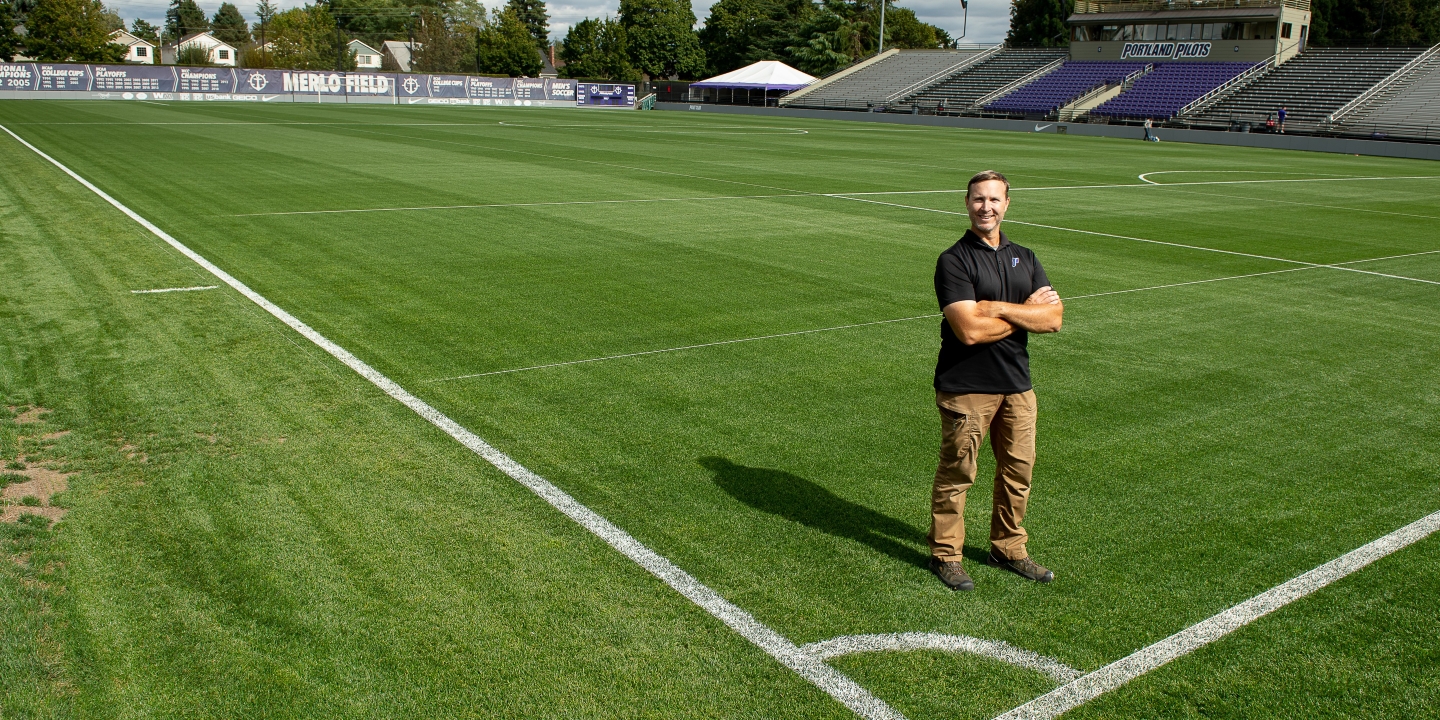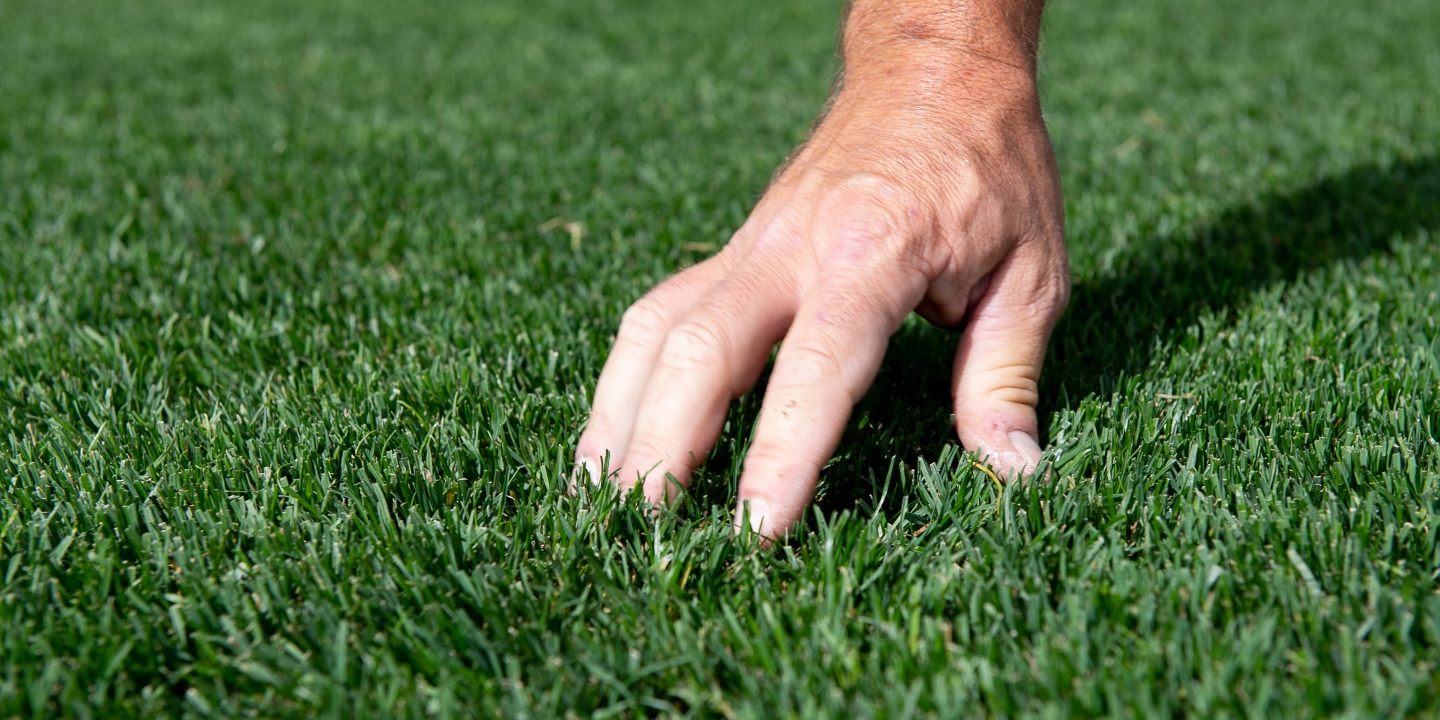Fall 2022
Where the Grass Is Always Greener
How has UP's Merlo Field twice been named the best soccer field in the country? Through the meticulous care and devotion of Kevin White.
- Story by Cheston Knapp

Kevin White on UP's Merlo Field. Photo by Bob Kerns.
AN EMPTY SPORTS FIELD—it’s a lonely image. Without the excitement of a game, it enters the kind of purgatory we associate with unused toys. It has only the caretaker to keep it company and minister to its needs. To give it food and water, nurse its ailments, and protect it from rot and pests.
As I walked by Merlo Field in July, I found this lone devotee out there, pacing behind a large broadcast spreader that had fertilizer blooming around it like Pig-Pen’s dust cloud. At one point he paused, took a knee, and placed his palm on the grass, as though blessing it. So tender was the gesture that I felt like I was witnessing a private moment between old friends.
Kevin White has been UP’s Athletics Field Manager for seven years. Under his direction Merlo has twice been named the best college soccer field in the country. You could say he’s outstanding in the field of fields. As a younger man, he’d dreamed of becoming a golf course architect and kept a notebook where he’d doodle ideas for holes and course routings. But before pursuing a degree in turf management, he attended culinary school and worked as a baker for a little start-up grocery store called New Seasons.
“I like to think of myself as a science-minded person,” he said. “Which is what appealed to me about baking. Getting the ratios right, that was part of the challenge.”
The similarities between baking and growing grass are more striking than they might appear at first blush. Like golf greens, which Kevin maintained during the first leg of his turf career, Merlo sits atop a bed of sand, fourteen inches of it, a growing process akin to hydroponic farming. The inert material provides excellent drainage, and by removing the finicky variable of natural soil, Kevin can ensure the grass gets all the nutrients it needs to thrive. Follow the recipe and he’ll end up with a field that looks good enough to eat.

Photo by Bob Kerns
On the day we met, Portland was in the grips of a heatwave and Kevin planned to hit the grass with extra water to cool it off. Sensors buried in the sand give him readings of the field’s moisture, salinity, and temperature, but on especially hot days he’ll trust his eye to find the areas most affected by the sun. I followed him out onto the field, which was a vivid Crayola green. The sprinklers shushed like a chorus of annoyed librarians as they dowsed the far end. Something about the scene urged you to go barefoot.
“Be my guest,” Kevin said, and I doffed my kicks.
The grass was tacky underfoot, as though the blades had been dipped in honey or sap, and surprisingly soft. It’s mostly perennial ryegrass, a hardy bunchgrass favored by places like Wimbledon and The Masters. But Kevin also throws in a dash of Kentucky bluegrass, a resilient rhizome grass that spreads underground and helps with infill after routine wear and tear. As I walked around, though, I noticed that the field still looked a little young in places, with the incomplete coverage of bargain hair plugs.
“It’ll be full in another week or so,” Kevin said, confidently.
Like a lot of certified sports field managers, Kevin does everything he can to avoid using pesticides and other harsh chemical treatments. To rid Merlo of thatch, organic matter, and weed seeds, particularly those of his arch-nemesis, annual bluegrass, he’s adopted a relatively new technique called fraise mowing. At the end of each school year, right after commencement, Kevin uses a special harrow to tear up the lush sward he’s fostered all season long, composting more than a hundred tons of it. It’s a sacrifice you make full of fear and trembling, that feels like a huge mistake. But when it’s done right, it removes all the unwanted gunk while leaving the root system unharmed. There follows a dicey stage when the field is vulnerable to the sun, as your head would be after a buzz cut, and he has to guarantee it stays nice and moist.
Listening to him describe all the field demands of him, I wondered whether he dreamed about it.
“Not dreams,” he said. “But I do have nightmares. They’re all water-related.”
A couple weeks later I sat in the stands with my six-year-old son for opening day, a men’s and women’s double header. The field was indeed full, luxuriantly so. Snipped to a uniform one inch, it had freshly painted lines that put me in mind of Frosted Mini Wheats. As the women’s game began, I did my best to describe for my son everything happening on the field. When you cut bunchgrasses, I said, they send out new shoots called tillers as a defense mechanism. And those elegant stripes you see are created by the mower—it bends the grass ever so slightly, causing it to reflect sunlight. I quoted a favorite passage from the Talmud that goes, “Every blade of grass has its angel that bends over it and whispers, ‘Grow, grow.’ ” Not yet embarrassed by his old man, he offered me some of his popcorn and continued to listen with the attention of an acolyte. At halftime, with the women up 4-0, the sprinklers kicked on to rewet the field, which makes for a fast and consistent playing surface. Sunlight hung in the water, creating a rainbowy mist, and through this heavenly veil you could see Kevin out there, fixing divots, looking every bit like Merlo’s angel.
CHESTON KNAPP is Portland magazine's senior writer and associate editor.